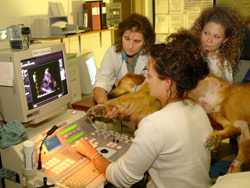Doctors Perform First Successful Heart Bypass at the College of Veterinary Medicine
College Station – In a collaborative effort, veterinarians and human health professionals worked together to perform the first successful heart bypass surgery at the College of Veterinary Medicine, Texas A&M University. On Saturday, October 20, Dr. Theresa W. Fossum, Professor of Surgery and Endowed Chair and Dr. David Nelson, Clinical Assistant Professor from the College of Veterinary Medicine, Dr. Mark Felger, a cardiovascular surgeon with Cardiothoracic and Vascular Associates of Austin, Texas and their surgical team performed surgery on Luke, a two-and-a-half year-old Golden Retriever from, San Antonio, Texas.

“Luke had a condition known as sub-aorta stenosis, which is one of the most common congenital heart defects,” said Dr. Sonya Gordon, a Veterinary Cardiologist at the college who has overseen Luke’s treatment since he was a puppy. “Usually, this condition causes sudden death before the patient turns three years of age. Over the past few months, Luke has lost weight and we knew that we were running out of time.”
The 92-minute heart procedure included surgical entry through the right ventricle, through the septum into the left ventricle to remove the obstruction. “We took out a large window of tissue in the septum which relieved some of the pressure and allowed us to see better into the left ventricle. The window in the thickened septum was repaired with a thin patch made from Luke’s own tissue.”
While a similar procedure has been performed on children, this approach was considered aggressive treatment in animals. “Colorado State has done a series of these cases using a different approach which hasn’t been determined to change the long term survival of the patient,” said Gordon.
In measuring the speed of blood flowing through Luke’s heart doctors saw a vast improvement in his condition. The blood flow went from eight meters per second before surgery to 3.3 meters per second after surgery. “This is a tremendous improvement. The narrower the opening, the faster the blood flows and the harder the heart has to work,” added Gordon.
What is not known is how much damage was done to Luke’s heart over the past two-and-a-half years and whether that damage is reversible. “We will see Luke in a month, and then again in three months. If everything goes as hoped, he will have annual checkups and as a result of the bypass surgery, live to a ripe old age,” said Gordon.
Due to the life-threatening nature of the condition, plans were made to attempt a surgical correction of the problem. However, a year ago when the plans were first discussed, there weren’t a lot of options.
The Michael E. DeBakey Institute for Comparative Cardiovascular Science and Biomedical Devices was established at the College of Veterinary Medicine at Texas A&M University in 1999 to facilitate such procedures. However, bringing the necessary expertise and equipment together takes time. “We are still in the process of building a heart surgery program so that we can perform bypass procedures on pets and other animals,” said Fossum. “We are fortunate to have an outstanding team of surgeons, cardiovascular perfusionists, anesthetists, and a cardiothoracic criticalist on staff to help us build the heart surgery program.”
The program is in need of funding to purchase a dedicated ultrasound machine and other equipment necessary for sophisticated heart procedures. “Heart disease, including the need for valve replacement or repair, is common in dogs,” said Fossum. “It is expensive to set up a program like this and to make these procedures available.” Many people, like Cindy Norris, Luke’s owner, love their animal and desire to seek advanced medical attention for their pet, but can’t afford the tremendous cost of surgery.
“When Luke was a puppy I took him to the veterinarian and she didn’t like what she heard. The results of that examination were devastating. Over time, Luke’s condition kept getting worse. When he was four months old, I prayed for a miracle and this successful procedure is my answer,” said Norris.
Luke was discharged on Friday, October 26th, after veterinarians and technicians working on his case presented him and owner Norris with a cake and a Texas A&M University sweatshirt signed by members of the surgical team.
Established in 1916, the College of Veterinary Medicine at Texas A&M University is one of the world’s leading institutions in animal health care and research.
###
For more information about the Texas A&M College of Veterinary Medicine & Biomedical Sciences, please visit our website at vetmed.tamu.edu or join us on Facebook, Instagram, and Twitter.
Contact Information: Jennifer Gauntt, Director of CVMBS Communications, Texas A&M College of Veterinary Medicine & Biomedical Sciences; jgauntt@cvm.tamu.edu; 979-862-4216


